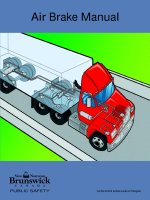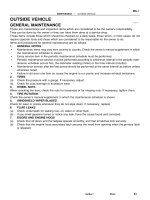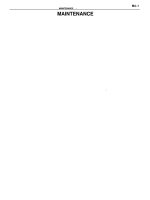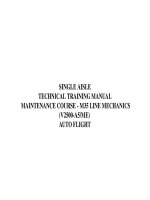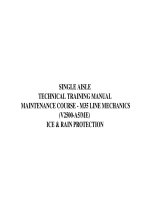UDCU02 01GB maintenance manual DCU80 100 2020
Bạn đang xem bản rút gọn của tài liệu. Xem và tải ngay bản đầy đủ của tài liệu tại đây (13.65 MB, 252 trang )
Empty container handler 8-10
tonnes
Publ. no UDCU02.01GB
Maintenance Manual in original
MAINTENANCE MANUAL
DCU80–100
A Foreword
B Safety
C Preventive maintenance
0 Complete machine
1 Engine
Maintenance Manual
DCU80–100
2 Transmission
3 Driveline/axle
4 Brakes
5 Steering
6 Suspension
7 Load handling
8 Control system
9 Frame, body, cab and accessories
10 Common hydraulics
11 Common electrics
12 Common pneumatics
D Error codes
E Schematics
F Technical data
G Terminology and index
A:1
A Foreword
Contents A Foreword
Foreword ............................................................................................................A:3
About the maintenance manual ...................................................................... A:3
General ...................................................................................................... A:3
Conditions .................................................................................................. A:3
Storage....................................................................................................... A:3
About the machine version......................................................................... A:3
Copyright .................................................................................................... A:3
Reading instructions ....................................................................................... A:4
Warning information ................................................................................... A:4
Important information ................................................................................. A:4
Read operator's manual ............................................................................. A:4
Read maintenance manual ........................................................................ A:4
Maintenance manual's content................................................................... A:5
Function group structure ............................................................................ A:6
Product alternatives and optional equipment ............................................. A:7
Machine card.............................................................................................. A:8
About the documentation ................................................................................ A:9
The documentation's parts ......................................................................... A:9
Ordering of documentation......................................................................... A:9
Feedback ................................................................................................... A:9
Maintenance Manual DCU80–100
UDCU02.01GB
A:2
UDCU02.01GB
Maintenance Manual DCU80–100
A Foreword – Foreword
A:3
A Foreword
About the maintenance manual
General
Thank you for selecting Cargotec as your machine supplier. We hope
that we will meet your expectations.
The maintenance manual contains information about how the machine
should be maintained for maximal operating reliability and service
life as well as troubleshooting information for fast correction of any
malfunctions.
Conditions
The instructions are based on use of general tools available in stores.
All lifting devices, e.g., straps, slings, ratchet blocks, etc., must meet
governing national regulations for lifting devices.
Cargotec will not accept any responsibility for modiications performed
without permission from Cargotec or in the event of the use of lifting
devices, tools or work methods other than those described in this
manual.
Storage
NOTE
The maintenance manual shall be accessible to service personnel.
About the machine version
The information in this publication corresponds to the machine's
design and appearance when delivered from Cargotec. There may be
differences due to customisation of the machine.
Cargotec reserves the right to change speciications and equipment
without prior notiication. The information in the manual is valid at the
time of publication.
DANGER
External equipment may only be used if it is approved
by Cargotec.
Risk of fatal accidents and property damage!
Use only equipment approved by Cargotec.
Copyright
Cargotec Sweden AB
Duplication of the content in this manual, in whole or in part, is strictly
prohibited without written permission from Cargotec Sweden AB.
Duplication by any means such as copying, printing, etc., is prohibited.
Maintenance Manual DCU80–100
UDCU02.01GB
A:4
A Foreword – Reading instructions
Reading instructions
Warning information
Warnings inform of potential hazards that, if warnings are not heeded,
may result in personal injury or product damage.
DANGER
Situation that may lead to severe personal injury or
fatality if the rule is not followed.
WARNING
Situation that may lead to personal injury if the rule
is not followed.
CAUTION
Situation that may lead to product damage if the rule
is not followed.
Important information
Important information is indicated by NOTE, and is provided to
facilitate the work process, handling or increase understanding of the
information.
NOTE
Information that is important without being related to safety.
Read operator's manual
000262
The symbol to the left is used in certain cases on the machine and
refers to important information in the operator's manual.
Read the operator's manual
001128
Read maintenance manual
The symbol to the left is used in certain cases on the machine and
refers to important information in the maintenance manual.
Read the maintenance manual
UDCU02.01GB
Maintenance Manual DCU80–100
A Foreword – Reading instructions
A:5
Maintenance manual's content
The information in the maintenance manual is divided into function
groups (0-12) to facilitate searching for information. The manual is
divided in 20 sections A-C, 0-12, D-G. The sections with letters contain
speciic information that applies to several function groups and is not
bound to a function, e.g., section "F Technical data". This is described
in greater detail in the table below.
For more information about function groups, see Function group
structure, page A:6.
A
Foreword
General information about the maintenance manual's purpose, content and
reading instructions as well as survey for feedback of views and eventual
inaccuracies.
B
Safety
Keep in mind for your safety.
C
Preventive maintenance
General information about preventive maintenance of the machine.
Instructions for lubricating and checking for cracks over the entire machine.
0
Complete machine
1
Engine
2
Transmission
3
Driveline/Axle
4
Brakes
5
Steering
6
Suspension
7
Load handling
8
Control system
9
Frame, body, cab and
accessories
10
Common hydraulics
11
Common electrics
12
Common pneumatics
D
Error codes
Error code information is found in the Workshop manual and Operator's manual.
E
Diagrams
Wiring diagrams and hydraulic diagrams are found in the Workshop manual.
F
Technical data
Technical data, conversion tables, information for conversion of units.
G
Terminology and index
General terminology and abbreviations, explanations of terms and abbreviations
that may appear in the manual, index for headings in the manual.
Work instructions for preventive maintenance.
Maintenance Manual DCU80–100
UDCU02.01GB
A:6
A Foreword – Reading instructions
Function group structure
The information in the manual is divided in a structure of functions at
different levels, based on the machine's design and use, called function
groups.
The upper level (called main group) determines group, e.g., group 7
Load handling. The second level (called two-digit) determines function,
e.g., 7.2 Lifting/lowering. The third and fourth levels are used to break
down functions into smaller parts (components).
The function groups' structure for main group and two-digit group level
are common for all machines from Cargotec, e.g., 4.3 Power-assisted
brake system. Machine-unique adaptations of function groups are
done at the third and fourth group level, e.g., 4.3.9 Wheel brake and
4.3.9.1 Disc pack. This means that some function groups (headings)
will be left out of the documentation for certain machines since the
machine does not have that particular function or component. In turn,
this means that the function groups' numbering may 'skip', e.g., the
three-digit heading level 4.8.7 Oil cooler may be included for some
machines but not for others.
The idea is that the function groups are intended to work as a search
term to ind different types of information between different sections and
manuals. The information under a function group is divided into smaller
sections according to the type of content, e.g., description or change.
The maintenance manual and workshop manual contain different
information. The maintenance manual only includes information
needed for preventive maintenance. The workshop manual includes
more in-depth information and repair instructions.
References are indicated by either section and group numbers, e.g.
"see section 4 Brakes, group 4.3.9 Wheel brakes" or with the section
and page number, e.g. "see Fuel level sensor, description page 4:24"
where 4:24 denotes section 4 Brakes, page 24.
References are not given between Maintenance manual and Workshop
manual. If more information is desired for a function group, the primary
recommendation is to search under the same function group in the
other manual.
UDCU02.01GB
Maintenance Manual DCU80–100
A Foreword – Reading instructions
A:7
Product alternatives and optional equipment
000264
Product alternatives
Symbol indicating optional equipment
The information in the manual is divided in modules. For product
alternatives and optional equipment, handling of the modules differs
depending on if it is the one or the other that is described, see below.
Special equipment is not described in the manual. If you're uncertain
about what equipment the machine should have, use the machine card
to decide which information applies, see Machine card, page A:8.
Product alternatives
Product alternatives are such options that exclude certain standard
equipment (e.g. engine option).
Equivalent information for different product alternatives is described
in separate sections following each other under the same function
group. To indicate that there are different alternatives, the supplement
"Product alternative" is used in the heading together with a simple
description of which alternative is described, e.g., "(Product alternative
Climate control unit ECC)". In addition, alternatives that are optional
are marked with the symbol for optional equipment.
Optional equipment
Optional equipment consists of options that can be added to the
standard equipment to obtain additional or improved functions.
Information for optional equipment is described in separate sections
with the standard equipment as starting point. Description of the
optional equipment describes how the standard function is affected by
the option as well as which additional components are added.
Maintenance Manual DCU80–100
UDCU02.01GB
A:8
A Foreword – Reading instructions
Machine card
NOTE
If the machine has been modiied after delivery the information on
the machine card may be lacking or incorrect.
IMPORTANT
Changes done on the machine shall be reported to
Cargotec so that the machine card can be updated.
A new updated machine card is sent on the request
of the customer.
The machine card indicates of which drawings the machine consists,
in many cases these can be associated to options and product
alternatives. For more information on handling product alternatives and
optional equipment, see Product alternatives and optional equipment,
page A:7. The machine card is supplied together with the spare
parts catalogue and should be stored in the cab as an aid to service
personnel.
The machine card is divided in the same function groups as the spare
parts catalogue, maintenance manual, and workshop manual. For
practical reasons, the machine card only uses the irst and second
level of the function group index. The function groups are written in
groups of four characters, e.g., group 0107 corresponds to group 1.7
Cooling system in the manual.
For more information about how the machine card is used for ordering
spare parts, see the parts catalogue's foreword.
If the information on the machine card does not help, contact Cargotec.
NOTE
All documents that accompany the machine are non-registered
documents and there will be no notiication of changes.
UDCU02.01GB
Maintenance Manual DCU80–100
A Foreword – About the documentation
A:9
About the documentation
The documentation's parts
The documentation for the machine consists of the following parts:
Operator's manual
The operator's manual is delivered with the machine in the cab.
Documentation kit
Maintenance manual, spare parts catalogue and machine card are
supplied for the machine as a separate documentation kit.
Supplementary documentation
Supplementary documentation can be ordered for the machine.
•
Workshop manual
•
Supplier documentation for engine, transmission, drive axle and
attachment.
Ordering of documentation
The documentation is ordered from the dealer for Cargotec.
Always specify publication number when ordering.
For publication number, see the machine card.
Feedback
Cargotec's ambition is that you who work with maintenance of Kalmar
machines shall have access to correct information.
Your feedback is important to be able to improve the information.
If you have any comments then please send them to the address below.
Thanks for your help!
Cargotec Sweden AB
Product Support
Movägen 1
SE-341 32 Ljungby
SWEDEN
Maintenance Manual DCU80–100
UDCU02.01GB
A:10
UDCU02.01GB
Maintenance Manual DCU80–100
B:1
B Safety
Contents B Safety
Safety..................................................................................................................B:3
General safety information.............................................................................. B:3
Safety concerns everyone!......................................................................... B:3
A near accident is a warning! ..................................................................... B:3
Safety instructions........................................................................................... B:4
General ...................................................................................................... B:4
Service position .......................................................................................... B:5
Hydraulic system, depressurising............................................................... B:6
Oils ............................................................................................................. B:7
Fuel system ................................................................................................ B:8
DEF (Diesel Exhaust Fluid) ........................................................................ B:9
Clothing, etc. ............................................................................................ B:10
Several mechanics on the same machine................................................ B:10
Working under the machine ..................................................................... B:11
Lifting heavy components ........................................................................ B:11
Vibrations ................................................................................................. B:12
Noise ........................................................................................................ B:12
Solvents ................................................................................................... B:12
Fire and explosion risks............................................................................ B:13
Fluid or gas under pressure ..................................................................... B:15
Coolant ..................................................................................................... B:16
Refrigerant ............................................................................................... B:16
Air pollution .............................................................................................. B:17
Tensioned springs .................................................................................... B:18
Electrical system and electric motors ....................................................... B:18
Rotating components and tools................................................................ B:18
Tyres and rims.......................................................................................... B:19
Lifting equipment ...................................................................................... B:19
Welding .................................................................................................... B:20
Spare parts............................................................................................... B:21
Non-ionised radiation ............................................................................... B:22
Environment.................................................................................................. B:23
General .................................................................................................... B:23
Maintenance Manual DCU80–100
UDCU02.01GB
B:2
UDCU02.01GB
Maintenance Manual DCU80–100
B:3
B Safety – Safety
B Safety
General safety information
Safety concerns everyone!
The safety information concerns everyone who works with the machine!
Persons who do not follow the safety instructions in this manual must
make absolutely sure that the work is performed without risks of
personal injury, without risks of machine damage, or property damage!
Remember to:
•
follow the instructions in this manual
•
be trained for the work in question
•
follow local laws, safety rules and regulations
•
use the correct equipment and tools for the job
•
wear the correct clothes
•
use common sense and be careful. Do not take any risks!
Cargotec has in this publication documented and warned for situations
and risks that may occur in connection with using as well as service or
repairs of the machine during normal circumstances.
Therefore, it is very important that all who work with the machine, or
carry out repairs or service work, acquaint themselves with and act
according to the information in the Operator's Manual, Maintenance
Manual and Workshop Manual.
A near accident is a warning!
An incident is an unforeseen event where neither a person, the
machine, nor property is damaged. However, incidents indicate that
there is a risk of injury and actions must be taken to avoid injury risks.
Maintenance Manual DCU80–100
UDCU02.01GB
B:4
B Safety – Safety instructions
Safety instructions
General
Read, consider and follow the safety instructions below before starting
to work in the machine:
UDCU02.01GB
•
Service position, page B:5
•
Hydraulic system, depressurising, page B:6
•
Oils, page B:7
•
Fuel system, page B:8
•
DEF (Diesel Exhaust Fluid), page B:9
•
Clothing, etc., page B:10
•
Several mechanics on the same machine, page B:10
•
Working under the machine, page B:11
•
Lifting heavy components, page B:11
•
Vibrations, page B:12
•
Noise, page B:12
•
Solvents, page B:12
•
Fire and explosion risks, page B:13
•
Fluid or gas under pressure, page B:15
•
Coolant, page B:16
•
Refrigerant, page B:16
•
Air pollution, page B:17
•
Tensioned springs, page B:18
•
Electrical system and electric motors, page B:18
•
Rotating components and tools, page B:18
•
Tyres and rims, page B:19
•
Lifting equipment, page B:19
•
Welding, page B:20
•
Spare parts, page B:21
•
Non-ionised radiation, page B:22
Maintenance Manual DCU80–100
B Safety – Safety instructions
B:5
Service position
General
General
Service position is used for service, maintenance and other situations
when the machine needs to be secured.
Service position means:
•
Machine parked, that is, applied parking brake.
•
Lifting carriage and attachment in completely lowered position.
•
Engine off.
•
System voltage off (with battery disconnector).
Machine with lifting carriage and attachment in
completely lowered position
Maintenance Manual DCU80–100
UDCU02.01GB
B:6
B Safety – Safety instructions
Hydraulic system, depressurising
Before the hydraulic system is opened
1
Machine in service position, see Service position, page B:5.
2
Depressurise the hydraulic system by opening the relief valve for
the attachment (A).
DANGER
Fatal danger!
Extreme danger exists when working with hydraulics
when the hydraulic system is pressurised.
Depressurise the hydraulic system. Open the
accumulator drain valve.
3
Loosen lock nut (C) and open the drain valve for the brake
accumulators (B).
4
Turn the start key to position I and activate the hydraulic functions
to depressurise the hydraulic system.
5
Turn the start key to position 0.
6
Disconnect the system voltage with the battery disconnector.
NOTE
Keep the accumulator drain valve open as long as work is in
progress.
After the work has been completed
7
Close the relief valve for the attachment (A) and the drain valve for
the brake accumulators (B). Tighten the lock nut (C).
8
Start the engine and activate the hydraulic functions.
9
Turn off the engine.
10 Check that the hydraulic connections are sealed tightly.
UDCU02.01GB
Maintenance Manual DCU80–100
B Safety – Safety instructions
B:7
Oils
The following safety instructions shall be followed for work when
handling oils.
WARNING
Warm and pressurised oil.
Always depressurise the hydraulic system before
starting work in the system. The hydraulic system is
pressurised and its oil can cause personal injury.
Avoid skin contact with the oil, use protective gloves.
Hot oil may cause burns, rashes and irritation! The
oil can be corrosive to the eyes and skin, as well as
mucous membranes in the throat.
CAUTION
Always clean the area around components and
connections before loosening them, and plug the
connections. Dirt in oil systems causes increased
wear, which results in material damage.
Always take actions to avoid spills. Where a container
cannot be used for draining, use a pump or hose for
safe handling.
Always check that plugs seal tight before collection
containers are moved.
Handle all oil as environmentally hazardous waste.
Oils freely released cause damage to the environment
and may also start ires. Waste oils/luids shall always
be handled and taken care of by companies that are
authorised for this work.
Maintenance Manual DCU80–100
UDCU02.01GB
B:8
B Safety – Safety instructions
Fuel system
The following safety instructions shall be followed for work when
handling fuel.
DANGER
Pay attention to the risk of ire when working on the
fuel system.
Work on the fuel system must be avoided when the
engine or exhaust system is hot since fuel can spill on
hot surfaces and may ignite. Allow the engine and
exhaust system to cool before carrying out work on
the fuel system.
Ensure that naked lames, sparks or red-hot/glowing
objects have been extinguished before starting work
on or in the vicinity of the fuel system.
Do not smoke in the vicinity of the machine when work
on the fuel system is in progress.
WARNING
The engine's fuel system operates at very high
pressure. The pressure is so high that the jet can
damage the skin, which results in serious injuries.
Risk of personal injury.
Use protective gloves and protective safety goggles,
avoid skin contact with fuel. If a component is to be
loosened, hold a rag over the coupling as protection
and collect the fuel. Fuel can be corrosive to the eyes
and skin, as well as mucous membranes in the throat.
CAUTION
Always clean the area around components and
connections before loosening them, and plug
the connections. Dirt in the fuel system causes
malfunctions and engine stops in unwanted situations,
as well as increasing wear and material damage as a
consequence.
Always take actions to avoid spills. Where a container
cannot be used for draining, use a pump or hose for
safe handling.
Always check that plugs seal tight before collection
containers are moved.
Handle the fuel as environmentally hazardous waste.
Fuel freely released causes damage to the environment
and may also start ires. Fuel shall always be handled
and taken care of by companies that are authorised
for this work.
UDCU02.01GB
Maintenance Manual DCU80–100
B Safety – Safety instructions
B:9
DEF (Diesel Exhaust Fluid)
The following safety instructions must be followed for work when
handling DEF.
WARNING
DEF spilled on hot components evaporates quickly.
DEF can cause irritation in the event of contact with
skin and eyes, as well as if inhaled.
Health hazard!
Turn your face away. Vaporised DEF can be corrosive
to the eyes, as well as mucous membranes in the
throat. In the event of inhalation, breathe fresh air and
seek medical advice if necessary.
Handle with care and avoid contact with skin and eyes,
use protective gloves and protective safety glasses.
In the event of contact with skin and spillages on
clothing, rinse the skin with large amounts of water and
replace contaminated clothing and gloves. In the event
of contact with eyes, rinse thoroughly with water for
several minutes and seek medical advice if necessary.
CAUTION
Switch off the engine and wait at least ive minutes
before working on the DEF system.
Risk of unnecessarily large spill.
When the engine is switched off, the DEF system
pumps back the DEF in the lines to the DEF tank. Allow
this process to run to completion before starting work
in order to reduce spill quantity.
CAUTION
DEF is very corrosive and penetrating.
DEF is extremely aggressive to wiring.
Wiring that has come into contact with DEF must be
replaced.
IMPORTANT
Avoid spilling DEF on the ground and in watercourses.
Spillages on the ground must be absorbed with sand
or other absorbent, non-combustible material.
Maintenance Manual DCU80–100
UDCU02.01GB
B:10
B Safety – Safety instructions
Risks
DEF is very corrosive and penetrating, spills not cleaned cause
damage to wiring, machine and tools. In the event of a spill there is a
risk that DEF causes oxidisation that is impossible to remove. Cleaning
with compressed air and water is not enough since DEF oxidises the
metal itself.
Safety actions
•
Before working on the DEF system, switch off the engine and
wait for two minutes so that the DEF system can pump back the
solution to the tank. Do not switch off the system voltage with the
battery disconnector before two minutes have elapsed.
•
If a connector has been exposed to DEF solution, it must be
replaced immediately so that the DEF solution does not seep
further into the wiring. DEF seeps at a speed of 0.6 m/h in
wiring.
•
Clean the machine immediately in the event of a spill in order to
prevent damage.
•
Clean tools after the service work has been completed in order
to prevent damage.
•
Fully protect all electrical connectors before the work, such as with
the DEF system's tank and lines.
•
Always protect the DEF system's hoses, pump unit, metering valve
and tank when they are disconnected in order to prevent spills
and to protect the system against contaminants. Use a plastic
bag and straps.
Clothing, etc.
Clothes should be in good repair. Remove loose, hanging items (e.g.,
tie, scarf). Do not wear clothes with wide sleeves, pant legs, etc.
Remove jewellery as it may conduct electricity and get caught in
moving parts.
Long hair should be put up securely since it may otherwise get caught
in moving parts. Be careful when working with a welder or open lame
since hair is lammable.
Several mechanics on the same machine
WARNING
If several mechanics are working on the same vehicle,
be extra careful so that accidental movements do not
injure another person. Communicate so that everyone
knows where everyone is and what they are doing.
Risks
Movements performed from the operator's station, e.g., all movement
of lifting equipment, may cause severe personal injuries.
Safety actions
UDCU02.01GB
•
Make sure that the machine's lifting equipment is completely
lowered or secured in another way.
•
Move the battery disconnector to position zero and remove the key.
•
Be aware of the risks when several persons work around the
vehicle.
•
Make your co-workers aware of what you're working with.
•
Do not work with the drive wheels on both sides of the truck at the
same time if the drive wheels on both sides are raised.
Maintenance Manual DCU80–100
B:11
B Safety – Safety instructions
Working under the machine
Working under the frame
A machine must not be moved if anyone is underneath it.
A raised vehicle may not, for any reason, be supported or lifted in
parts that belong to the wheel suspension or steering. Do not support
under mudguards or tanks either. Always support under the frame or
drive axle.
Risks
Serious injury may occur if a machine is moved when someone is
underneath it.
Mechanical or hydraulic tools and lifting devices can fall over or
accidentally be lowered due to malfunctions or incorrect use.
Safety actions
•
Place clear warning symbols, e.g. at the cab entry or on the
steering wheel, when work is being carried out under the machine.
•
Use axle stands that withstand the load and stand securely.
•
Lifting tools should be inspected and type approved for use.
Lifting heavy components
WARNING
Careless handling of heavy components may lead to
serious personal injury and material damage.
Use type approved lifting tools or other devices to
move heavy components. Make sure that the device
is sturdy and intact.
Risks
Unsuitable lift slings, straps, etc. may break or glide.
The centre of gravity of the component can change during the course of
the work, and the component may then make unexpected movements
which may cause severe personal injuries and material damage.
A component lifted with lifting equipment can start to turn if the centre
of gravity changes.
A component lifted using an overhead crane may start to swing back
and forth, which can cause severe crushing injuries or material damage.
Safety actions
Lift with lifting device. Use lifting tools or other devices, especially
when such items are available for certain jobs. Use a protective safety
helmet if there is a risk of head injury.
If lifting must be performed without lifting device:
•
Lift near the body.
•
Keep your back vertical. Raise and lower with your legs and arms,
do not bend your back. Do not twist your body while lifting. Ask for
assistance - before lifting.
•
Wear gloves. They're often good protection to reduce crushing
and cutting injuries to ingers.
•
Always use protective shoes.
Maintenance Manual DCU80–100
UDCU02.01GB

